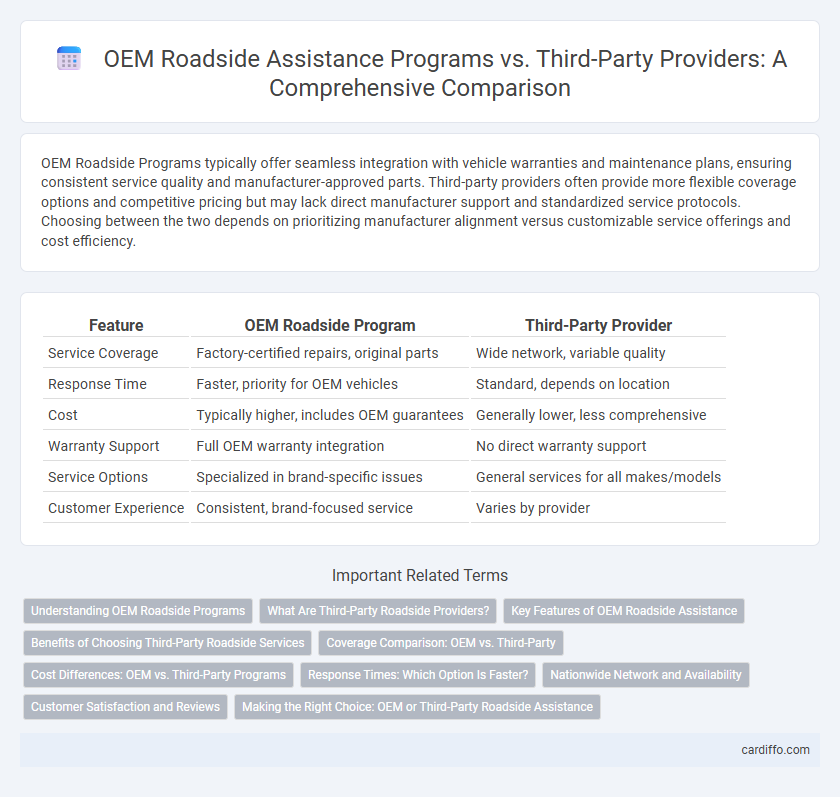OEM Roadside Programs typically offer seamless integration with vehicle warranties and maintenance plans, ensuring consistent service quality and manufacturer-approved parts. Third-party providers often provide more flexible coverage options and competitive pricing but may lack direct manufacturer support and standardized service protocols. Choosing between the two depends on prioritizing manufacturer alignment versus customizable service offerings and cost efficiency.
Table of Comparison
| Feature | OEM Roadside Program | Third-Party Provider |
|---|---|---|
| Service Coverage | Factory-certified repairs, original parts | Wide network, variable quality |
| Response Time | Faster, priority for OEM vehicles | Standard, depends on location |
| Cost | Typically higher, includes OEM guarantees | Generally lower, less comprehensive |
| Warranty Support | Full OEM warranty integration | No direct warranty support |
| Service Options | Specialized in brand-specific issues | General services for all makes/models |
| Customer Experience | Consistent, brand-focused service | Varies by provider |
Understanding OEM Roadside Programs
OEM roadside programs offer tailored vehicle assistance directly from the manufacturer, ensuring compatibility with specific car models and often include original parts for repairs. These programs provide seamless service integration, faster response times, and exclusive benefits such as extended warranties or complimentary roadside coverage. OEM support is designed to maintain vehicle performance and preserve resale value compared to generic third-party providers, which may lack manufacturer expertise.
What Are Third-Party Roadside Providers?
Third-party roadside providers offer emergency vehicle services independently from automobile manufacturers, delivering assistance such as towing, tire changes, and lockout services through a network of contracted service providers. Unlike OEM roadside programs integrated into the vehicle purchase or warranty, third-party providers allow drivers to customize coverage plans based on individual needs and budget. These providers often benefit from competitive pricing and broader service area availability, catering to a diverse range of vehicle makes and models.
Key Features of OEM Roadside Assistance
OEM Roadside Assistance programs offer comprehensive vehicle coverage tailored to specific car brands, including services such as towing, tire changes, and fuel delivery performed by certified technicians using original parts. These programs provide seamless integration with vehicle warranties and often include additional benefits like software updates and priority service at authorized dealerships. The direct link to manufacturers ensures higher reliability, faster response times, and enhanced customer satisfaction compared to third-party providers.
Benefits of Choosing Third-Party Roadside Services
Choosing third-party roadside services offers greater flexibility with providers who specialize in rapid response and cost-effective solutions tailored to diverse vehicle types. These services often provide extended coverage options beyond OEM warranties, enhancing accessibility in more locations and reducing wait times. Customers benefit from competitive pricing and a wider network of technicians, ensuring quick and reliable assistance during roadside emergencies.
Coverage Comparison: OEM vs. Third-Party
OEM roadside programs typically offer comprehensive coverage tailored specifically for their vehicles, including manufacturer-certified repairs and genuine parts, ensuring optimal service quality and warranty compliance. Third-party providers often provide broader coverage options across multiple vehicle brands with competitive pricing, though repair quality and parts authenticity may vary. Comparing coverage, OEM programs prioritize brand-specific expertise and reliability, whereas third-party plans emphasize flexibility and cost-effectiveness.
Cost Differences: OEM vs. Third-Party Programs
OEM roadside assistance programs typically feature higher upfront costs due to comprehensive services and manufacturer-backed warranties, while third-party providers offer more competitive pricing with flexible coverage options tailored to individual needs. Third-party programs often emphasize affordability and customizable plans, potentially sacrificing some OEM-specific benefits or exclusive perks linked directly to vehicle manufacturers. Analyzing cost differences requires weighing total service value against price, considering variables like service frequency, geographic coverage, and included benefits.
Response Times: Which Option Is Faster?
OEM Roadside Programs typically offer faster response times due to direct manufacturer support and dedicated service networks optimized for specific vehicle models. Third-party providers may experience variability in response speed caused by different service partners and broader coverage areas. Data from industry reports show OEM programs can reduce wait times by up to 30% compared to third-party roadside assistance services.
Nationwide Network and Availability
OEM Roadside Programs offer a comprehensive nationwide network that ensures seamless service availability through certified technicians and authorized repair facilities, maintaining consistent quality and vehicle warranty compliance. Third-party providers may have extensive coverage but often lack uniform service standards and direct manufacturer support, potentially causing variable availability and service quality. Nationwide network strength and reliable availability make OEM programs more dependable for maintaining vehicle integrity during roadside assistance.
Customer Satisfaction and Reviews
OEM Roadside Programs typically offer higher customer satisfaction due to direct manufacturer support, seamless warranty integration, and consistent service quality verified by numerous positive reviews. Third-party providers may offer competitive pricing and broader coverage but often receive mixed customer feedback related to service reliability and claim processing times. Data from consumer reports consistently shows OEM programs outperform third-party services in overall satisfaction scores and repeat customer loyalty.
Making the Right Choice: OEM or Third-Party Roadside Assistance
Choosing between an OEM roadside assistance program and a third-party provider requires evaluating coverage scope, response time, and cost efficiency. OEM programs often offer manufacturer-specific benefits like warranty integration and specialized service expertise, while third-party providers typically present broader network access and competitive pricing. Assessing vehicle age, driving habits, and plan flexibility is crucial to making an informed decision that ensures comprehensive roadside support.
OEM Roadside Program vs Third-Party Provider Infographic

 cardiffo.com
cardiffo.com